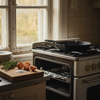Aluminum Foil in Bottom of Oven: What Home Chefs Need
Key Takeaways
- Many home chefs use aluminum foil to line the bottom of the oven to catch drippings and reduce cleaning time.
- Placing aluminum foil on the oven floor can cause problems, including potential damage or safety hazards.
- Using foil as a shortcut may lead to melted messes that are harder to clean than the original drippings.
- It's important to understand the risks before deciding to place aluminum foil in the bottom of your oven.
Table of Contents
- Should You Put Aluminum Foil in the Bottom of Your Oven? (Straight Answers, Zero Sugarcoating)
- The Science (and Dangers) Behind Aluminum Foil in Ovens
- Common Reasons People Want to Use Aluminum Foil, And What Really Works
- Safe Methods to Protect Your Oven, No Aluminum Required
- If Aluminum Foil Gets Stuck or Melted, Don't Panic, Here's What to Do
- Aluminum Foil vs. Today's Best Oven Protection Options, Head-to-Head
Aluminum Foil in the Bottom of the Oven: What Every Home Chef Needs to Know (and Why Your Oven Will Thank You)
Picture this: you're prepping for Sunday dinner, and that gorgeous roast is about to go in the oven. You grab a sheet of aluminum foil to line the bottom, because who wants to scrub burnt drippings later? Hold up, chef. Before you create what could become a melted mess or worse, let's talk about why putting aluminum foil in bottom of oven might not be the shortcut you're hoping for.
Here's the thing, your oven is a precision instrument, not just a hot box. That innocent sheet of foil can block airflow, reflect heat in ways that mess with your cooking, and in some cases, actually melt onto your oven floor. But don't worry, we've got better solutions that'll keep your oven spotless without the drama.
If you're looking for tools that make oven cleanup easier and safer, consider using a silicone spatula set for scraping up spills or a 2-piece silicone spoon set for serving and mixing without damaging your bakeware.
Should You Put Aluminum Foil in the Bottom of Your Oven? (Straight Answers, Zero Sugarcoating)
The short answer: No. Most oven manufacturers explicitly advise against placing aluminum foil directly on the oven bottom. For gas ovens, it can block crucial ventilation. For electric ovens, it can interfere with heating elements and sensors. Both scenarios can damage your oven and void your warranty.
What Manufacturers Say, And Why They're Not Just Covering Their Backs
GE, Whirlpool, KitchenAid, and virtually every major oven manufacturer include specific warnings against aluminum foil in bottom of oven placement in their manuals. This isn't legal paranoia, it's engineering reality. These companies have tested thousands of units and know exactly what happens when foil interferes with their carefully designed airflow patterns and heat distribution systems.
What Actually Happens When You Ignore the Manual
When you place foil on the oven bottom, you're essentially creating a heat reflector that wasn't part of the original design. In gas ovens, this can block the vents that allow combustion gases to escape safely. The result? Poor heat circulation and potential carbon monoxide buildup.
Electric ovens face different but equally problematic issues. The foil can cause hot spots by reflecting heat back to the bottom heating element, potentially causing it to overheat. At temperatures above 500°F, think pizza night or high-heat roasting, aluminum foil can actually begin to break down and bond with your oven's enamel coating.
Your oven's temperature sensors also get confused when foil disrupts normal heat patterns, leading to uneven cooking and extended cooking times. That perfectly timed roast? It might come out overdone on top and raw in the middle.
The Science (and Dangers) Behind Aluminum Foil in Ovens

How Aluminum Foil Changes the Way Your Oven Heats
Ovens rely on both radiant heat (direct heat from elements) and convection (air circulation) to cook food evenly. Aluminum foil is highly reflective, bouncing radiant heat back toward the heating elements instead of allowing it to circulate naturally. This creates temperature inconsistencies, some areas become scorching hot while others stay cooler than intended.
Potential Hazards, From Fire Risks to Fried Electronics
While aluminum foil melts at 1220°F, well above typical cooking temperatures of 350-550°F, the real danger lies in what happens before it reaches that point. At sustained high temperatures, foil can warp, tear, and make contact with heating elements. In electric ovens, this contact can cause electrical shorts or element damage.
| Risk | Description | When It Occurs | Prevention |
|---|---|---|---|
| Element Damage | Foil contacts heating element causing shorts | High heat + loose foil placement | Never place foil on oven bottom |
| Enamel Bonding | Foil melts onto oven floor coating | Temperatures above 500°F | Use oven-safe liners on racks instead |
| Poor Ventilation | Blocked airflow in gas ovens | Any foil placement covering vents | Keep oven floor completely clear |
| Uneven Cooking | Heat reflection disrupts temperature zones | Any reflective surface on oven bottom | Use proper drip-catching alternatives |
For a deeper dive into the science and safety of using foil, see this official food safety resource on cooking safely with aluminum foil.
Common Reasons People Want to Use Aluminum Foil, And What Really Works
Top 3 Problems Home Chefs Are Trying to Solve:
- Catching drips and spills from roasts, casseroles, and bubbling dishes
- Making cleanup easier by preventing baked-on messes
- Protecting oven surfaces from stubborn stains and burnt-on food
While these are valid concerns, using aluminum foil on the oven floor isn't the safest or most effective solution. Let's look at the real risks and better alternatives:
| Risk Type | Description | When It Occurs | Prevention |
|---|---|---|---|
| Element Damage | Foil contacts heating elements, causing shorts or burns | Electric ovens, high temps (500°F+) | Never place foil directly on oven floor |
| Enamel Bonding | Foil melts and permanently fuses to oven surface | Self-clean cycle or sustained high heat | Use silicone liners on racks instead |
| Poor Ventilation | Blocked airflow causes uneven cooking | Gas ovens, any temperature | Keep oven vents completely clear |
| Sensor Interference | Temperature readings become inaccurate | Modern ovens with digital controls | Allow natural heat circulation |
If you're interested in creative oven recipes that don't require risky shortcuts, check out this guide to oven roasted salmon with lemon dill for a delicious, mess-free meal.
Safe Methods to Protect Your Oven, No Aluminum Required
Silicone Oven Liners: Your Forever-Clean Secret Weapon
DI ORO's pro-grade, forever-chemical-free silicone liners handle temperatures up to 600°F without breaking down or releasing toxins. Unlike aluminum foil, they're designed to work with your oven's airflow, not against it. Place them on racks below your cooking dishes to catch drips while maintaining proper heat circulation. Our America's Test Kitchen award-winning silicone technology means these liners wash clean in seconds and last for years.
When Parchment and Baking Paper Save the Day
Parchment paper works safely up to 450°F and won't interfere with oven mechanics. Secure edges under baking dishes to prevent curling toward heating elements. While less durable than silicone, parchment offers convenience for single-use protection and costs significantly less than repairing oven damage from melted foil.
Racks, Trays, and Pizza Stones: Let's Get Creative
Position a rimmed baking sheet on the rack below messy dishes to catch overflow without blocking oven vents. Pizza stones work double duty, they stabilize temperatures and act as indirect heat barriers for delicate items. The key is maintaining at least two inches of clearance around all oven walls for proper airflow.
| Method | Max Safe Temp | Reusability | Health Safety | Cleanup |
|---|---|---|---|---|
| DI ORO Silicone Liner | 600°F | Years of use | Forever-chemical free | Dishwasher safe |
| Parchment Paper | 450°F | Single use | Food-grade safe | Disposable |
| Rimmed Baking Sheet | 500°F+ | Indefinite | Stainless steel safe | Standard dishwashing |
| Pizza Stone | 900°F | Years of use | Natural stone | Hand wash |
Best Oven Protection Methods at a Glance
| Method | Max Safe Temp | Reusability | Health Safety | Cleanup Required | Recommended Brand |
|---|---|---|---|---|---|
| Aluminum Foil | 1220°F (melts) | Single use | Potential chemical leaching | Can bond permanently | Not recommended |
| Silicone Liner | 600°F | Years of use | Forever-chemical free | Rinse and dry | DI ORO Pro-Grade |
| Parchment Paper | 450°F | Single use | Food-safe coating | Dispose after use | Unbleached varieties |
| Rimmed Baking Sheet | 500°F+ | Indefinite | Stainless steel safe | Standard dishwashing | Heavy-gauge steel |
For more baking inspiration and oven-safe tools, browse our baking collection for everything you need to keep your kitchen running smoothly.
If Aluminum Foil Gets Stuck or Melted, Don't Panic, Here's What to Do

Why Melted Foil Happens and How Bad It Can Get
Enamel bonding occurs when aluminum foil in bottom of oven reaches temperatures above 500°F, particularly during self-clean cycles that hit 900°F. Older ovens and thin, bargain foil create the perfect storm for permanent fusion. The aluminum literally becomes part of your oven's surface, creating rough patches that collect grease and become impossible to clean normally.
How to Safely Remove Melted Foil (Step-by-Step)
Apply a commercial oven cleaner containing sodium hydroxide to the affected area. Wait 20 minutes for the chemical reaction to soften the bond. Using a plastic scraper or DI ORO's heat-resistant silicone spatula, gently work at the edges of the melted foil. Repeat the process if needed, patience prevents enamel damage. Always wear gloves, open windows for ventilation, and never mix cleaning products.
When DIY Isn't Enough: Time to Call the Manufacturer?
Stop scraping if you see enamel chipping or if the foil covers more than a palm-sized area. Contact your oven manufacturer about replacement bottom plates, many offer this service for $50-150, far less than buying a new oven. Document the damage with photos before attempting removal, as some warranties cover this type of repair.
Quick Safety Tips Every Home Chef Should Know
- Never use steel wool or metal scrapers on enamel surfaces
- Don't attempt removal on a hot oven, wait for complete cooling
- Avoid mixing different cleaning products, which can create toxic gases
- Test cleaning solutions on a hidden area first
- Keep pets and children away during the cleaning process
For more tips on kitchen safety and clever cooking, you might also enjoy our article on dutch oven cooking for hearty, one-pot meals.
Aluminum Foil vs. Today's Best Oven Protection Options, Head-to-Head
How Does Aluminum Foil Stack Up?
When comparing aluminum foil in bottom of oven against modern alternatives, the results are clear. Aluminum foil offers immediate availability and low upfront cost, but fails on safety, durability, and cooking performance. Silicone liners cost more initially but provide superior heat tolerance, zero health risks, and years of reliable service. Parchment paper splits the difference, safe for moderate temperatures and disposable convenience.
Pros, Cons, and Suitability for Every Type of Home Chef
Occasional bakers benefit most from parchment paper's simplicity and safety margin. Frequent home chefs should invest in quality silicone liners that pay for themselves through durability and consistent performance. Professional-level home kitchens demand the reliability and food safety standards that only forever-chemical-free silicone provides.
Brand Test Results and Expert Recommendations
America’s Test Kitchen consistently recommends against foil liners, citing safety and performance concerns. Food Network's testing highlights DI ORO's silicone technology as the gold standard for oven safety tools. Our award-winning spatulas and liners use the same pro-grade, forever-chemical-free silicone trusted by professional kitchens nationwide.
For further reading on why you should never put foil on the oven bottom, see this in-depth guide from Wirecutter.
If you want to upgrade your kitchen tools, explore our award winning kitchen utensils for professional results at home.
Frequently Asked Questions
Why do oven manufacturers advise against placing aluminum foil on the bottom of the oven?
Oven manufacturers advise against placing aluminum foil on the bottom because it can block essential ventilation and interfere with heating elements or sensors. This disruption can damage the oven’s performance and may void the warranty.
What are the potential safety hazards of using aluminum foil in a gas or electric oven?
Using aluminum foil in a gas oven can block gas flow or ventilation, creating a fire hazard, while in electric ovens, foil can cause overheating or damage to heating elements. Both situations increase the risk of oven malfunction or even fire.
How does aluminum foil affect the airflow and heat distribution inside an oven?
Aluminum foil can block or redirect airflow, disrupting the oven’s carefully designed heat circulation. This leads to uneven cooking, hot spots, and can cause the oven to work harder or overheat in certain areas.
What are safer alternatives to aluminum foil for protecting the oven floor and making cleanup easier?
Safer alternatives include using oven liners specifically designed for heat resistance and easy cleaning, or placing a baking sheet on a lower rack to catch drips. Additionally, tools like silicone spatulas help clean spills without damaging your oven or bakeware.




